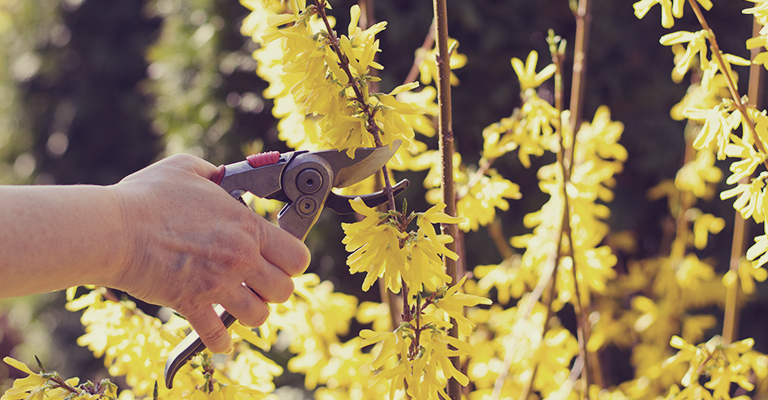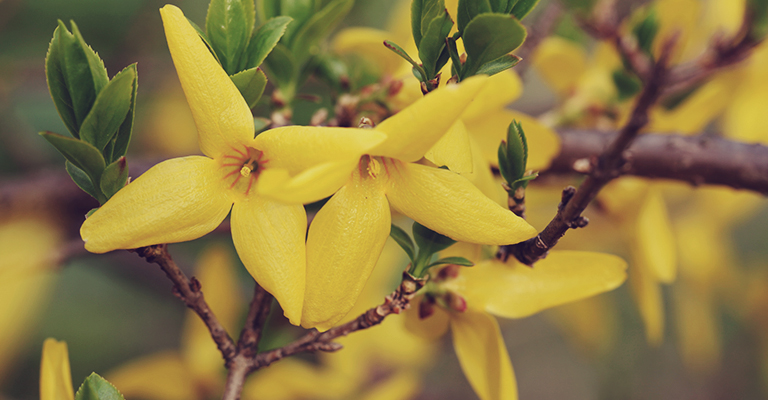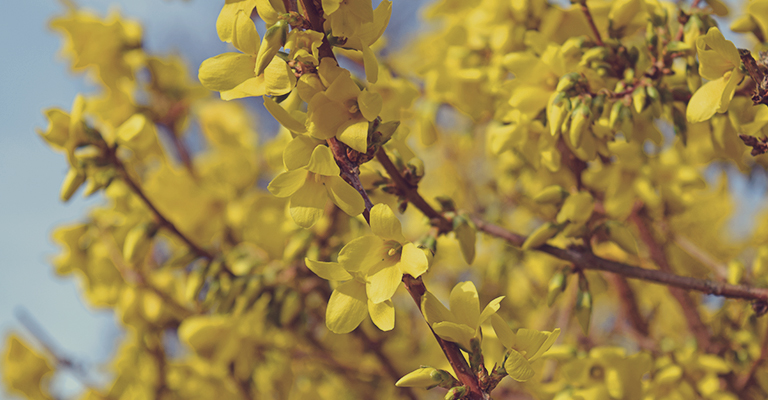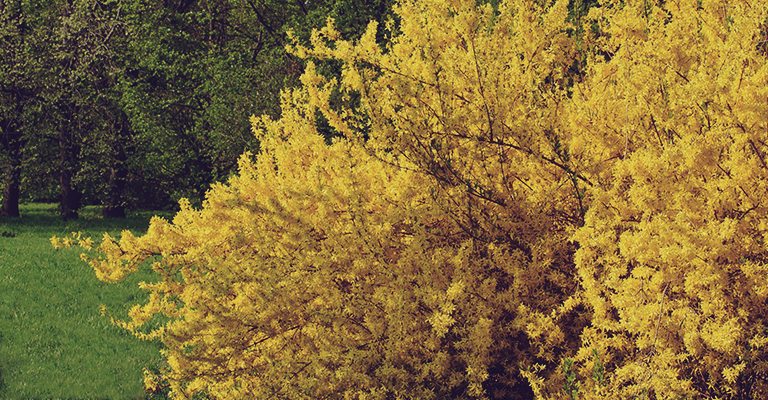
Forsythia is undoubtedly one of the most popular early flowering shrubs, and for good reason! While its peers still seem to be unsure that winter is indeed over, it’s already producing dazzling yellow flowers that are simply spectacular amidst the post-winter bleakness... Provided, of course, that it was pruned at the right time.
Pruning your forsythia is not essential, but it allows the shrub to keep an aesthetic bushy habit... and it promotes sensational flowering at the start of the season as well.
When to prune forsythia?
ALWAYS prune forsythia in the month (2 months at most) following flowering. This is regardless of whether it is formative, maintenance or rejuvenation pruning. Therefore, forsythia is generally pruned in May, but that depends on the cultivar and the region you live in.
The reason is simple. The new shoots, both vigorous and very tender, take some time to appear. Pruning early in the spring gives them time to form flower buds the following spring and harden off in the garden before winter sets in.

How to prune forsythia?
Depending on the age and condition of your shrub, various pruning types are possible.
Formative pruning
Young plants are pruned in the first season after planting. Commercial cultivars are usually trained, while those from cuttings will require more care in the early years to achieve a balanced plant.
Tip: Overly drooping branches must also be pruned.
Maintenance pruning
Doing this annually allows you to preserve your shrub’s uniform habit and to limit its size.
Tip: If you find that your shrub has grown too large, cut each branch to a third of its current length. When trimming branches, always prune above a sturdy bud.
Rejuvenation pruning
This should be done every three or four years. The young shoots of forsythia are mainly formed in the middle of older branches. The shrub becomes very dense in places but eventually some parts start to thin out. After only a few years, the flowering of a shoot is not what it used to be. Cutting the largest branches each year helps to keep a young and vigorous plant while maximizing its flowering.
Tip: You can easily prune a third of the branches. Cut off heavily ramified branches down to the first stem growing upwards. Cut the oldest branches (those that are big and grey) about 6 inches from the ground.
Radical rejuvenation pruning for forsythia
Your forsythia won’t develop adequately and you’re wondering what to do? When it is not pruned regularly, its abundant flowering is inevitably affected. An ornamental shrub left to itself for many years will necessarily need a more drastic rejuvenation pruning to rebalance its shape and renew its branches.
Tip: Cut the branches at ground level, keeping only 4 or 5 of the strongest ones. Perform the rejuvenation pruning early in the spring so that the plant has time to regenerate before winter. After 3 years, your shrub will be the star of the neighbourhood again.
Regular pruning for a forsythia hedge
In the case of a forsythia hedge, it is suggested to prune every year, in order to preserve its compact habit. It is also recommended to thin the heart of the shrubs every three or four years by removing the oldest branches. Given the nature of forsythia, it forms a loose hedge. Trying to control it into a perfectly tidy hedge would require you to prune at mid-season and remove the flower buds of the following spring. To somewhat discipline anarchic regrowth during the summer, it is possible to pinch.
Tip: Before pruning, check the condition of your tools. Sharpen them and sanitize them. A clean cut promotes good healing and reduces the risk of spreading diseases.

How to prune a new forsythia shrub?
You’ve envied your neighbour’s forsythia for years and finally decided to get your own?
To maximize flowering, choose a location in full sun. Your shrub will flower less in partial shade. Your forsythia will appreciate a well-drained soil, acidic or alkaline, and not too dry. And if you haven't chosen your cultivar yet, refer to the last section of this article for the hardiest varieties that flower in the spring, even after a particularly harsh winter.
Here’s how to prune your new acquisition:
Tip: Once pruning is complete, the shape of your shrub should be harmonious and regular, its branches well distributed around it.
How to save a seemingly lost cause?
Do you have a forsythia that’s so bad looking you consider getting rid of it every year? Before making an irreparable decision, perform a drastic rejuvenation pruning. If its condition does not improve in two or three years, you may need to get a cultivar better suited to your area.

A matter of variety and hardiness
Despite all the care you give it, your forsythia keeps disappointing you? Be aware that flowering is not guaranteed even if most of the forsythias available on the market are hardy in zone 3.
In fact, if the shrub is hardy in zone 3, its flower buds may not be. If this is the problem with your shrub, you will notice your plant gets through the winter without too much trouble, but flowering only occurs at its base, where enough snow has accumulated to protect it. Obviously, this is very disappointing. And unfortunately too common. Sometimes there is no alternative but to replace your forsythia with a hardier and more trustworthy variety.
Here are some suggestions for cultivars whose flower buds bloom in zones 4 and 5, sometimes even in zone 3. Remember that it’s easy to get a forsythia to bloom… provided you plant a variety adapted to our climate.
Safe bets:
Subscribe to our newsletter to receive our gardening tips, news and more directly in your inbox! Fill in the form below. Please note that fields with an * are required.